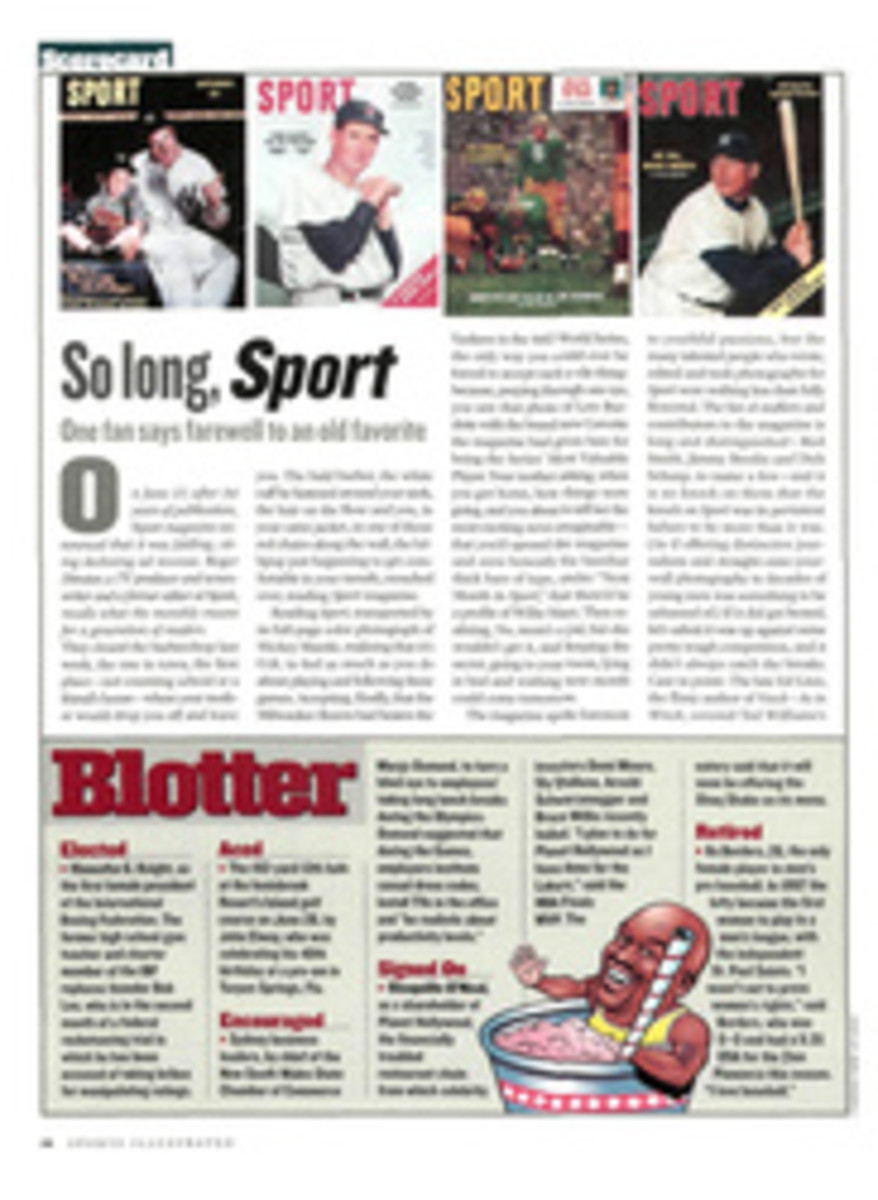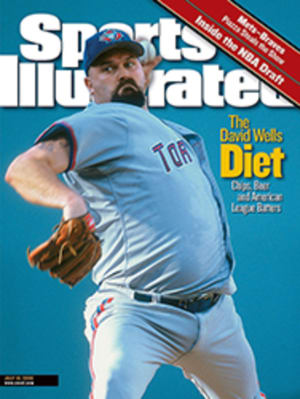
Notebook
Woods's Weakness
His Rock Won't Always Roll
Tiger Woods had the best putting week of his life during the U.S.
Open at Pebble Beach. On skinned, crusty greens with severe slope
and confounding break, he didn't three-putt once, was rock solid
from inside six feet and made a number of crucial par saves that
he called the key to his 15-stroke victory. Even though Woods hit
seven more greens (51) than anyone else, he tied for sixth in
total putts (110).
Nevertheless, putting expert Dave Pelz, unlike many of the
players left in the 24-year-old's backwash at Pebble, isn't ready
to call Woods a flat-stick virtuoso. "Putting is still Tiger's
biggest weakness," Pelz says. "If you accept that since turning
pro Tiger has improved his ball striking and shotmaking 100
percent, I'd say he's only improved his putting about 50 percent.
No question he has become more consistent. He's always been great
when he's on, and now his bad days aren't so bad. But he can get
significantly better on the greens."
Woods's pro career has been peppered with flurries of erratic
short putting distinguished by power lip-outs and failed slam
dunks that leave even longer putts coming back. His approach is
still more jackhammer operator than fly-fisherman.
Pelz, whose new book, Dave Pelz's Putting Bible, is probably the
most comprehensive study of putting ever written, thinks Woods's
grip, posture and alignment are excellent, as are the mechanics
of a pendulum stroke that stays low to the ground. Says Pelz, "He
has grooved his impact so that he hits really solid putts."
Pelz believes that Woods's problems have to do with mind-set.
"Tiger has a very strong mind, which is what gives him that rare
ability to pull off shots under pressure," he says. "It's one of
his greatest gifts, but on the greens it tends to make him force
things. Instead of focusing on the right speed--which I contend is
four times more important than line--he tries to jam the ball into
the hole, and that's when he is cutting down his percentages.
When he misses a few early in a round, he tries harder, and
things tend to get worse."
A manifestation of Woods's approach is tension in his forearms
and grip, something Pelz says the great putters avoid. "You can
see the tendons in Tiger's arms flexing," says Pelz. "It makes
him tight rather than flowing. The best putters are softer."
As a model, Pelz points to Loren Roberts, the vaunted Boss of the
Moss, whose syrupy stroke and ability to have putts die at the
hole are the envy of his peers. "Loren is soft and rhythmic,"
says Pelz, "and he takes the approach that he's going to make the
best putt he can and accept what happens. He doesn't try to force
it. I know Tiger has won 13 tournaments in the last two years,
but if Loren Roberts had been putting for him, he would have won
20 or 25."
Pelz also believes that Woods can improve his skills around the
green. "He's fantastic with the flop shot, especially out of high
grass," says Pelz, "but Tiger relies on it a little too much. I'd
like to see him develop more variety in his short game as well as
more of the softness that's going to help his putting."
Still, Pelz says that Woods, under the direction of Butch Harmon,
is on the right path. He liked the adjustment Woods made before
the Open--gripping the putter higher up the shaft to allow the
head to swing more easily. "His arms and even his facial muscles
looked more relaxed at Pebble," says Pelz. "Tiger's been burned
enough times lipping out that he's backing off and not trying as
hard to make every short putt straight. He's not quite there yet
with the proper speed, but he's much, much closer.
"With Tiger's work ethic, intelligence and talent, it's just a
matter of time before he puts it together," Pelz adds. "He'll
start having more weeks on the greens like he did at Pebble, and
that secret weapon he has--the ability to make the big putt--will
become even more powerful."
Armed for the Old Course
Illegal Drivers Galore at British
There's no way of knowing for sure until the first round of the
British Open is under way, but about a fifth of the 156-man field
at St. Andrews is expected to use one of the 11 titanium drivers
that have been outlawed by the USGA. The drivers, ruled to have
excessive springlike effect, are banned in the U.S., Canada and
Mexico but can still be played in the rest of the world, which is
governed by the Royal and Ancient Golf Club of St. Andrews.
Several players who have tried the clubs, which are under review
by the R&A, have reported gains of between six and 20 yards in
distance but a loss of accuracy. St. Andrews is an ideal site on
which to try the drivers because the Old Course has exceptionally
wide fairways.
At the moment, the most prominent player using one of the illegal
drivers is New Zealand's Michael Campbell, ranked 31st.
Third-ranked Colin Montgomerie put one in play for the first
round of the Deutsche Bank-SAP Open in May but switched to his
old club after hitting a few drives in the rough. No U.S.-based
players have said they will definitely use one of the clubs at
St. Andrews, but David Duval and Steve Elkington have been
experimenting with them. "No one is saying what he's going to
do," says Olin Browne, "but my guess is that there will be some
surprises. Elk told me that he is just killing it, and I know if
I were playing [Browne did not enter the tournament], I would
definitely have that club in my bag. Why not?"
COLOR PHOTO: ROBERT BECK Pelz says Woods could win twice as often if he relaxed on the greens.
COLOR PHOTO: SHARON CANTILLON
COLOR PHOTO: BUFFINGTON STUDIO
COLOR PHOTO: MIKE HASKEY
COLOR PHOTO: ROBERT CLARK
DOSSIER
LEWIS CHITENGWA
Age 25 World Rank 912
Height 5'11" Weight 152
Born Harare, Zimbabwe
Residence Nashville
Distinction Chitengwa, 61st on the Buy.com tour money list, is
the only black African-born player on a major U.S. tour.
How did you get into golf?
My parents are from the Shona tribe. My dad, Lewis Sr., caddied
at a private club in Harare. He wasn't allowed to play the
course because of his color, so in the '60s he and some other
caddies built a nine-hole course with sand greens. My father had
jobs working in an electrical plant and a bar until 1982, when
he became an administrator at another private club called
Wingate. That's where I started to shag balls for my dad and
learned to play."
Who taught you?
My father, who is now the head pro at Wingate, has been my only
teacher, and I swing like him. He taught me not to rely on
coaches, but to stick with my natural swing.
What was it like growing up in Harare?
I had it harder than most American kids, and that makes me more
determined. I walked four miles to school, but some cousins out
in the country walked 14 miles. They had no running water or
electricity, and I realized how much more I had in comparison.
When I think about that, I feel incredibly fortunate.
How is it being a black man in golf?
I haven't felt oppressed because of my skin color. The only time
it made a big difference was when I traveled to South Africa in
'93 for the South African Amateur. I had to convince a club
employee that I was a player, not a caddie. A lot of blacks came
out to support me. When I won, the people picked me up and threw
me in the air. I was the first black man to win that event."
How did you meet Tiger Woods?
I met Tiger when we played in the final group at the 1992 Orange
Bowl, which I won. We've never talked about being a role model
for minority and disadvantaged kids, but it is something I would
look forward to. When I visit Zimbabwe, the first thing the kids
ask me is if I know Tiger Woods. It's inspiring to see how much
influence he has had.
Is Nick Price a good mentor?
Nick, also from Zimbabwe, has been wonderful to me. He
encouraged me to accept a scholarship to Virginia before turning
pro, which I did. Nick and I speak three times a month. He's
always telling me I'm going to have to carry the Zim flag
because he's too old.
Trust Me
Despite what he says, Arnold Palmer isn't going to quit
tournament golf, nor should he. After missing the cut by 11
strokes in last week's U.S. Senior Open, Palmer worried that he
might ruin his reputation by "pushing it too far." He needn't be
concerned. There will always be a place for the "doggedest
victim of them all."
Foursomes
What do these Tour events have in common?
--Memorial
--Mercedes
--National Car Rental
--Western
Tiger Woods has won each of them twice. He took the Memorial in
1999 and 2000, the Mercedes in '97 and '00, the National Car
Rental in '96 and '99 and the Western in '97 and '99.
Feedback
Tiger Woods's hairline is rapidly receding. Should he take his
cue from Michael Jordan and shave his head?
Yes 19%
No 81%
--Based on 6,891 responses to our informal survey
Next question: If you had to choose today, who would get your
vote for the LPGA player of the year: Juli Inkster, Annika
Sorenstam or Karrie Webb? Vote at golfplus.cnnsi.com.
Numbers
By finishing 32nd at the Canon Greater Hartford
Open, Charles Howell got his professional career off to
a promising start. Here's how some other notables fared
in their pro debuts.
EVENT FINISH
Byron Nelson '32 Texarkana 3rd
Sam Snead '36 Cascades 3rd
Arnold Palmer '55 Brawley 17th
Sergio Garcia '99 Spanish 25th
Tom Watson '71 Kaiser 28th
David Duval '93 Hartford 38th
Ben Hogan '32 L.A. 38th
Jack Nicklaus '62 L.A. 50th
Tiger Woods '96 Milwaukee 60th
Hal Sutton '82 Bob Hope MC
Faces
Shawn Costello, Lansing, N.Y.
Shawn, who will be a senior at Lansing High, ran away with the
state high school championship, shooting a one-under 143 at the
Robert Trent Jones Golf Course at Cornell, in Ithaca, for an
11-shot victory. Shawn, the first boy to break par in the
tournament in five years, became the first Lansing High boy to
win a state title in any sport.
Caroline Ramsey, Bridgeport, W.Va.
Ramsey, 52, a retired college professor, was victorious in the
West Virginia senior amateur for the third consecutive year,
prevailing by six shots with an 11-over 155 at Alpine Lakes
Resort in Terra Alta. A two-time state amateur champ, Ramsey has
been the women's club champion at Bridgeport Country Club for
three of the last four years.
Wright Waddell, Columbus, Ga.
Waddell, 38, a stockbroker, shot a 14-under 270 at his home
course, the Country Club of Columbus, to claim his fourth
Southeastern Amateur Championship, by a shot over Pete Abernathy
of Jacksonville. A two-time Georgia Mid-Amateur champ, Waddell
also won the Southeastern in 1989, '94 and '96.
Submit Faces candidates to golfplus.cnnsi.com/faces.

